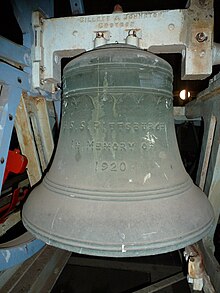USS Pennsylvania (ACR-4)
[4] In another of these early demonstrations, civilian aircraft designer and entrepreneur Glenn Curtiss taxied a hydroaeroplane alongside Pennsylvania as she lay anchored in San Diego Harbor, during the forenoon watch on 17 February 1911.[4] Recommissioning, Pittsburgh patrolled the west coast of Mexico, during the troubled times of insurrection that led to American involvement with the Veracruz landing in April 1914.[4] While at Rio de Janeiro, in October and November 1918, failure to implement quarantine procedures by Captain George Bradshaw, led to the spread of the deadly strain of Spanish influenza on ship, sickening 663 sailors (80% of the crew) and killing 58 of them.[6] Returning to the east coast, Pittsburgh prepared for duty as flagship for Commander, US Naval Forces in the eastern Mediterranean, for which she sailed from Portsmouth, New Hampshire on 19 June 1919.The following month, with Pittsburgh still in dry dock, a court-martial absolved Captain Todd of blame for the grounding but the navigator and watch officer were held accountable.When Chiang Kai-shek's National Revolutionary Army won control of Shanghai, in March, Pittsburgh resumed patrol operations and exercises with the Asiatic Fleet.Closing her long career of service, she carried the Governor General of the Philippines, Dwight F. Davis, on a courtesy cruise to such ports as Saigon, Bangkok, Singapore, Belawan, Batavia (Jakarta), Surabaya, Bali, Makassar, and Sandakan, returning to Manila, on 15 April 1931.Today, the ornament is on display at Soldiers and Sailors National Military Museum and Memorial; a replica of it is still in place at the modern Carnegie Mellon University.



USS PennsylvaniaUSS PittsburghPennsylvaniaPittsburghWilliam Cramp & SonsPhiladelphiaPennsylvania-classarmored cruiserlong tonsvertical triple expansionreciprocating enginesscrewsMarines8 in (203 mm)/40caliberbreech-loading rifles (BL)6 in (152 mm)/50 cal3 in (76 mm)/50 cal18 inch (450 mm)torpedo tubesBarbettesTurretsConning Tower8 in/45 calanti-aircraft gunsUnited States Navylead shipher classlaid downMatthew S. QuayCaptainCaribbean SeaAsiatic StationSan FranciscoEugene ElyCurtiss Model DTanforan RacetrackSan BrunoHunters PointSan Francisco BayGlenn CurtisshydroaeroplaneSan Diego HarborPuget Soundnaval militianew battleshipMexicoVeracruzflagshipAdmiralWilliam B. CapertonPacific FleetWorld War IBritishGermanArlington National CemeterySão Francisco Xavier CemeteryRio de JaneiroquarantineSpanish influenzaEllis M. Zachariasline officerGovernor of American SamoaGeorge LandenbergerPortsmouth, New HampshireAdriatic SeaAegean SeaBlack SeaFrenchBaltic SeaHMS DauntlessFrederickSheernessChatham DockyardNaval Forces EuropeGibraltarVice AdmiralCherbourg, FranceMarine DetachmentAmerican Expeditionary ForceBattle of Belleau WoodAmsterdamPhilip AndrewsRoger WellesYantaiShanghaiChiang Kai-shekNational Revolutionary ArmyDwight F. DavisSaigonBangkokSingaporeBelawanBataviaSurabayaMakassarSandakanManilaHampton RoadsLondon Naval TreatyBaltimore, MarylandCarnegie Institute of TechnologyPittsburgh, PennsylvaniaSoldiers and Sailors National Military Museum and MemorialRochester CathedralThe Evening StarThe New York TimesChetwynd, JoshPittsburgh Tribune-ReviewWikisourcepublic domainDictionary of American Naval Fighting ShipsNaval Vessel RegisterWikimedia CommonsInternet ArchivePennsylvania-class cruisersWest VirginiaHuntingtonCaliforniaSan DiegoColoradoPuebloMarylandSouth DakotaUSS BrooklynTennessee class